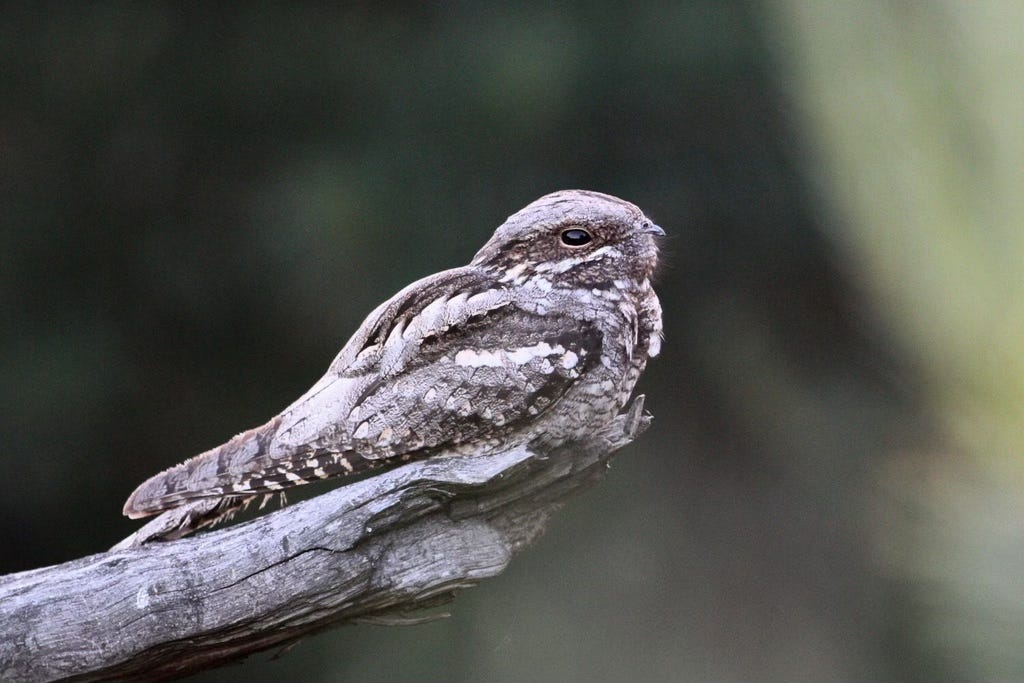I walked up to the woods yesterday evening, and there, dancing in the air, with the red band of sunset as stage backdrop, was the first nightjar of the year. No bird is more balletic; there were pirouettes, chassés, séautés, swoops, punctuated by dead-stops, every wing and tail feather air-braking. And then a vertical spin on the axis of its own spine, followed by slow traverse flutter, the bird becoming bat-like in the descending dimness as I trod into the springtime wood, the nightjar preceding me, leading me on.
The nightjar is celebrated for its weirdly mechanical purr-call, but the aerobatics of the summer nocturnal migrant surely merit their mention, including the extravagant, flamenco courtship display where nightjars clap their wings together over their back as they spin circles in the woodland glade in the moonlight. Churr or purr?
Or maybe J. A. Baker’s description of the bird’s song in the birdy classic The Peregrine as ‘the sound of a stream of wine spilling from a height into a deep and booming cask’. Meanwhile the poet Wordsworth considered the nightjar’s call to be positively unpoetic, a contemptible ‘frog-like’, with fellow poet John Clare describing the sound, in a concurrence, as ‘a trembling sort of crooing noise’. The numerous archaic common names for the nightjar have their utility in suggestive association for the purpose of identification by sound : ‘scissor grinder’, ‘razor grinder’ among them, whereas ‘wheel bird’, and ‘spinner’ may both allude to sound and motion.
Whatever the aesthetics of the bird’s crepuscular call, it the making of it constitutes a physical wonder. Almost all bird species sing whilst exhaling, requiring pauses to inhale; the male nightjar has evolved to sing continuously, altering amplitude and pitch to inhale as it emits 1,900 notes a minute.
Nightjars are also ventriloquists, the males swivelling their head as they purr, so their song pours down their backs, and swirls upon itself. Ventriloquism in birdsong is defence, the purpose to deceive predators as to the location of the singer who is perched in the open, preoccupied with performance of his chanson. The nightjar is magician multiplied. By day the bird lies camouflaged, in its vermiculated greys, browns, blacks, speckled white and gold; a physical mimicry of the tree bough it rests upon, pressing itself down, closing their large liquid eyes save for narrow tank slits through which they keep watch.
A Eurasian Nightjar
Nightjars always lie lengthways, ‘closing up’ in a rare phrase of ornithological poetry. As the sun moves, so they shift minutely, always facing the sun to minimize shadow. Since nightjars hunt visually, they need some light in the sky, against which their insect prey can be silhouetted; so twilight or moonlight. Like most summer avian migrants, Caprimulgus europaeus are determinedly carnivorous, aerial insects their diet. The mouth of the nightjar is wide, gaping, openable on two planes, vertical and horizontal, fringed by bill bristles which funnel cruelly the prey into the mouth-trap.
Moth-trap.
Moths comprise the bulk of the nightjar’s prey species, with beetles and true flies also significant. I could watch and hear nightjars until the cows come home, which in a sense I do here in south-west France. The nightjars of our Charente village inhabit woodland glade and edge, but also hunt over the barns and cow fields, flickering around the pale sculptures of slumbering Limousin cattle, the silhouettes of my void-dark recumbent sheep. The birds occupy the night space taken by swallows in day space. (‘Night swallow’, indeed, being an old country name for the bird.)
The nightjar’s elective affinity for the nocturnal farmyard gave rise in the past to all sorts of superstitions, notably that the bird siphoned milk from the teats of sleeping beasts. The nightjar, of course, is not a milk-snatcher but a ‘gnat hawk’, or ‘dor [beetle] hawk’, feasting on the insects of livestock excrement. It’s estimated that more than 40 per cent of all insect species across Western Europe are in decline. But where there is (organic) muck there’s insects. And where there are insects there are nightjars.
Such as at our house.





A gorgeous essay and introduction to the magical nightjar. Thank you for taking me on this journey. An American cousin to the nightjar is the nighthawk (Chordeiles minor) where I live, who “peents” while hunting insects, and makes a booming sound as air rushes through his primary feathers while diving.
Oh, I love this! I’m so happy I found you! I love birdwatching and use my Audubon app regularly and highly recommend it. I’m excited to read more to see which bird you’ll feature next.